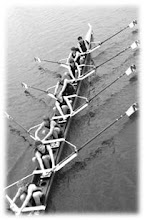Nutrition
by Marjorie T Hagerman
A 2,000m race requires all-out effort for approximately six to eight minutes. If a rower goes into the race having followed a proper diet during the preparatory training period, there should be enough glycogen stored in the muscles and liver to support the demands of the anaerobic/aerobic effort required. It is not necessary for a rower to superload the muscles with glycogen as a marathon runner or Tour de France cyclist might do. A rower's goal on race day, with regard to diet, is to have enough glycogen stored in the working muscles to fuel less than ten minutes of intense exercise. During such an intense effort, a rower will expend approximately 25 to 35 calories per minute, depending on individual body size and rate of metabolism. When the diet is optimal in carbohydrate, the body's working muscles can store up to 300 to 400 grams of glycogen (1,200 to 1,600 calories) to have available as fuel during exercise. The liver will contain stores of an additional 100 grams of glycogen (400 calories) that can be converted to glucose to fuel the exercising muscles. Fat can be stored by the body in larger amounts, and can also be used to fuel energy demands, however, carrying excess body fat is usually detrimental to performance. Fat is also less efficient than carbohydrate at producing calories from the limited amount of oxygen available during flat-out exercise.
The real issue, then, when looking at a rower's diet, is not what he or she eats on the day of the race, but whether they are able to maintain glycogen in the muscle at an optimum level to support their training regime for the days leading up to the competition. To support the high energy requirements of one or two vigorous training sessions on a daily basis requires a diet which is high in carbohydrate; adequate in protein, vitamins, minerals and fluids, and minimal in fat. Without attention to diet composition the rower runs the risk of gradually depleting glycogen stores during each training session and never allowing the muscle to fully regain its potential supply. This situation not only makes it difficult to obtain the greatest benefits from a training programme, it also means the athlete could enter the competition with glycogen stores that are unable to sustain an all-out competitive effort. At a recent team selection process, for example, an oarswoman participated in nutritional counselling, mainly because she was suffering from low energy and was unable to train at the level she wanted to. She thought that her low energy level might be due to a diet lacking in iron. Analysis, however, showed that, while her iron intake was fine, only 36% of her daily calories came from carbohydrate - well below the recommended 60% level. In reality, she was not eating enough carbohydrate foods to provide the necessary glycogen levels to support her training. Her goal was to change her diet to maximise her training and competitive efforts.
Courtesy of Concept2
Subscribe to:
Post Comments (Atom)

No comments:
Post a Comment